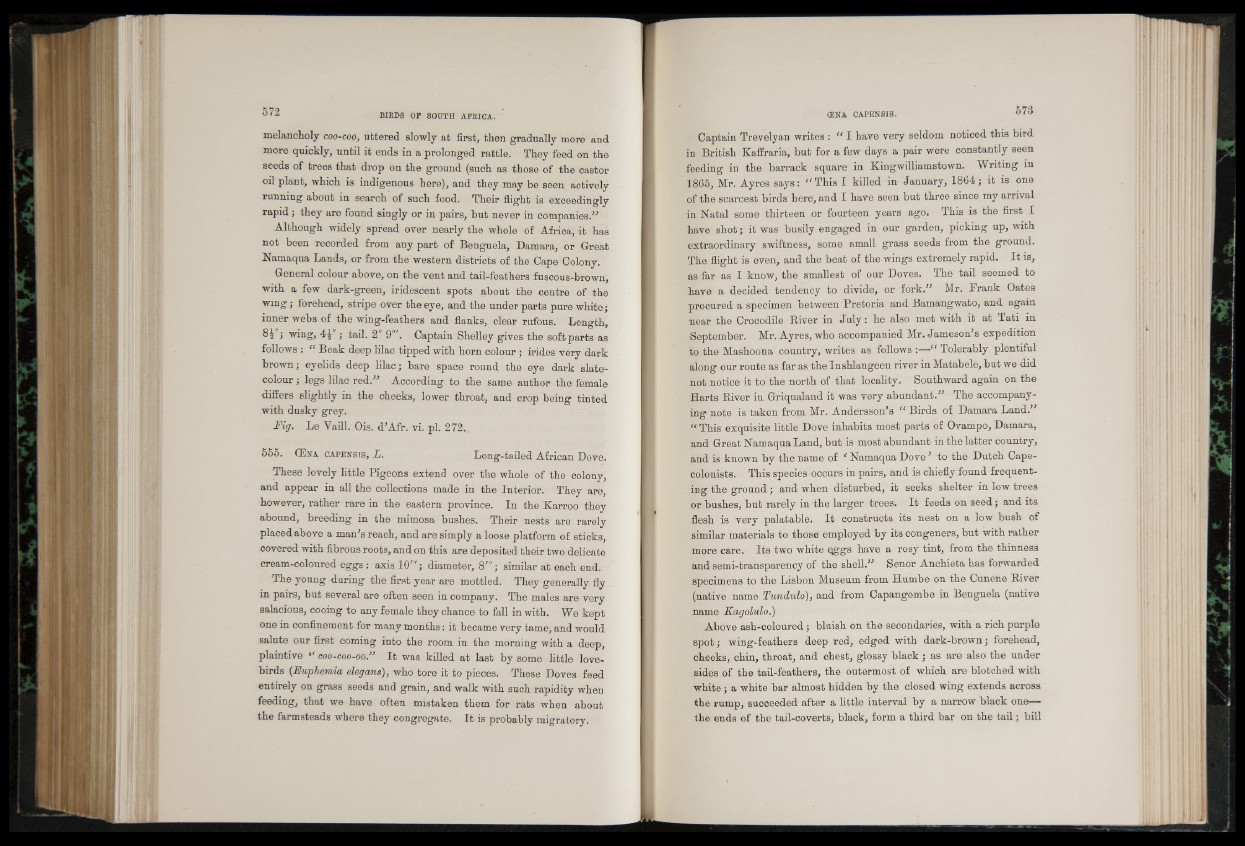
melancholy coo-coo, uttered slowly at first, then gradually more and
more quickly, until it ends in a prolonged rattle. They feed on the
seeds of trees that drop on the ground (such as those of the castor
oil plant, which is indigenous here), and they may be seen actively
running about in search of such food. Their flight is exceedingly
rapid; they are found singly or in pairs, but never in companies.”
Although widely spread over nearly the whole of Africa, it has
not been recorded from any part of Benguela, Damara, or Great
Namaqua Lands, or from the western districts of the Cape Colony.
General colour above, on the vent and tail-feathers fuscous-brown,
with a few dark-green, iridescent spots about the centre of the
wing ; forehead, stripe over the eye, and the under parts pure white;
inner webs of the wing-feathers and flanks, clear rufous. Length,
8^ ; wing, 4^ ; tail. 2 ' 9". Captain Shelley gives the soft parts as
follows • Beak deep lilac tipped with horn colour ; irides very dark
brown; eyelids deep lilac; bare space round the eye dark slate-
colour ; legs lilac red.” According to the same author the female
differs slightly in the cheeks, lower throat, and crop being tinted
with dusky grey.
Fig. Le Vaill. Ois. d’Afr. vi. pi. 272.
555. ( E n a c a p e n s i s , L. Long-tailed African Dove.
These lovely little Pigeons extend over the whole of the colony,
and appear in all the collections made in the Interior. They are,
however, rather rare in the eastern province. In the Karroo they
abound, breeding in the mimosa bushes. Their nests are rarely
placed above a man’s reach, and are simply a loose platform of sticks,
covered with fibrous roots, and on this are deposited their two delicate
cream-coloured eggs : axis 10"'; diameter, 8"'; similar at each end.
The young during the first year are mottled. They generally fly
in pairs, but several are often seen in company. The males are very
salacious, cooing to any female they chance to fall in with. We kept
one in confinement for many months: it became very tame, and would
salute our first coming into the room in the morning with a deep,
plaintive “ coo-coo-oo.” It was killed at last by some little lovebirds
(Euphemia elegans), who tore it to pieces. These Doves feed
entirely on grass seeds and grain, and walk with such rapidity when
feeding, that we have often mistaken them for rats when about
the farmsteads where they congregate. It is probably migratory.
Captain Trevelyan writes : “ I have very seldom noticed this bird
in British Kaffraria, but for a few days a pair were constantly seen
feeding in the barrack square in Kingwilliamstown. Writing in
1865, Mr. Ayres says: “ This I killed in January, 1864; it is one
of the scarcest birds here, and I have seen but three since my arrival
in Natal some thirteen or fourteen years ago. This is the first I
have shot; it was busily engaged in our garden, picking up, with
extraordinary swiftness, some small grass seeds from the ground.
The flight is even, and the beat of the wings extremely rapid. I t is,
as far as I know, the smallest of our Doves. The tail seemed to
have a decided tendency to divide, or fork.” Mr. Frank Oates
procured a specimen between Pretoria and Bamangwato, and again
near the Crocodile River in July: he also met with it at Tati in
September. Mr. Ayres, who accompanied Mr. Jameson’s expedition
to the Mashoona country, writes as follows :—“ Tolerably plentiful
along our route as far as the Inshlangeen river in Matabele, but we did
not notice it to the north of that locality. Southward again on the
Harts River in Griqualand it was very abundant.” The accompany-
insr note is taken from Mr. Andersson’s o “ Birds of Damara Land.
“ This exquisite little Dove inhabits most parts of Ovampo, Damara,
and Great Namaqua Land, but is most abundant in the latter country,
and is known by the name of ‘ Namaqua Dove’ to the Dutch Cape-
colonists. This species occurs in pairs, and is chiefly found frequenting
the ground; and when disturbed, it seeks shelter in low trees
or bushes, but rarely in the larger trees. I t feeds on seed; and its
flesh is very palatable. It constructs its nest on a low bush of
similar materials to those employed by its congeners, but with rather
more care. Its two white qggs have a rosy tint, from the thinness
and semi-transparency of the shell.” Senor Anchieta has forwarded
specimens to the Lisbon Museum from Humbe on the Cunene River
(native name Tundulo), and from Capangombe in Benguela (native
name Kagolulo.)
Above ash-coloured; bluish on the secondaries, with a rich purple
spot; wing-feathers deep red, edged with dark-brown; forehead,
cheeks, chin, throat, and chest, glossy black; as are also the under
sides of the tail-feathers, the outermost of which are blotched with
white; a white bar almost hidden by the closed wing extends across
the rump, succeeded after a little interval by a narrow black one—
the ends of the tail-coverts, black, form a third bar on the tail; bill